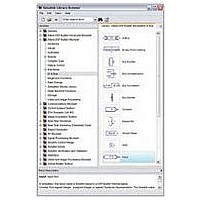IPTR-DSPBUILDER Altera, IPTR-DSPBUILDER Datasheet - Page 26

IPTR-DSPBUILDER
Manufacturer Part Number
IPTR-DSPBUILDER
Description
DSP BUILDER SOFTWARE
Manufacturer
Altera
Type
DSPr
Specifications of IPTR-DSPBUILDER
Function
DSP Builder
License
Renewal License
Software Application
IP CORE, DSP BUILDER
Core Architecture
FPGA
Core Sub-architecture
Arria, Cyclone, Stratix
Supported Families
Arria GX, Arria II GX, Cyclone, Stratix
Rohs Compliant
NA
Lead Free Status / RoHS Status
Not applicable / Not applicable
- Current page: 26 of 422
- Download datasheet (6Mb)
2–4
Creating the Amplitude Modulation Model
Create a New Model
DSP Builder Standard Blockset User Guide
f
f
For information about controlling the DSP Builder design flow using Signal
Compiler, refer to
page
For more information about the blocks in the DSP Builder blockset, refer to the
Builder Standard Blockset Libraries
This tutorial uses an amplitude modulation design example, singen.mdl, to
demonstrate the DSP Builder design flow.
The amplitude modulation design example is a modulator that has a sine wave
generator, a quadrature multiplier, and a delay element. Each block in the model is
parameterizable. When you double-click a block in the model, a dialog box displays
where you can enter the parameters for the block. Click the Help button in these
dialog boxes to view help for a specific block.
This tutorial assumes the following points:
■
■
■
You can use the singen.mdl model file in <DSP Builder install
path>\DesignExamples\Tutorials\GettingStartedSinMdl or you can create your
own amplitude modulation model.
To create the amplitude modulation model, follow these instructions.
To create a new model, follow these steps:
1. Start the MATLAB software.
2. On the File menu, point to New, and click Model to create a new model window.
3. In the new model window, on the File menu click Save.
4. Browse to a directory, your working directory, to save the file. This tutorial uses
5. Type the file name into the File name box. This tutorial uses the name singen.mdl.
6. Click Save.
7. Click the MATLAB Start button. Point to Simulink and click Library Browser.
You are using a PC running Windows XP.
You are familiar with the MATLAB, Simulink, Quartus II, and ModelSim
software and the software is installed on your PC in the default locations.
You have basic knowledge of the Simulink software.
f
the working directory <DSP Builder install
path>\DesignExamples\Tutorials\GettingStartedSinMdl\my_SinMdl.
3–19.
For information about using the Simulink software, refer to the Simulink
Help.
“Design Flows for Synthesis, Compilation and Simulation” on
Preliminary
section in volume 2 of the DSP Builder Handbook.
Creating the Amplitude Modulation Model
© June 2010 Altera Corporation
Chapter 2: Getting Started
®
DSP
Related parts for IPTR-DSPBUILDER
Image
Part Number
Description
Manufacturer
Datasheet
Request
R

Part Number:
Description:
CYCLONE II STARTER KIT EP2C20N
Manufacturer:
Altera
Datasheet:

Part Number:
Description:
CPLD, EP610 Family, ECMOS Process, 300 Gates, 16 Macro Cells, 16 Reg., 16 User I/Os, 5V Supply, 35 Speed Grade, 24DIP
Manufacturer:
Altera Corporation
Datasheet:

Part Number:
Description:
CPLD, EP610 Family, ECMOS Process, 300 Gates, 16 Macro Cells, 16 Reg., 16 User I/Os, 5V Supply, 15 Speed Grade, 24DIP
Manufacturer:
Altera Corporation
Datasheet:

Part Number:
Description:
Manufacturer:
Altera Corporation
Datasheet:

Part Number:
Description:
CPLD, EP610 Family, ECMOS Process, 300 Gates, 16 Macro Cells, 16 Reg., 16 User I/Os, 5V Supply, 30 Speed Grade, 24DIP
Manufacturer:
Altera Corporation
Datasheet:

Part Number:
Description:
High-performance, low-power erasable programmable logic devices with 8 macrocells, 10ns
Manufacturer:
Altera Corporation
Datasheet:

Part Number:
Description:
High-performance, low-power erasable programmable logic devices with 8 macrocells, 7ns
Manufacturer:
Altera Corporation
Datasheet:

Part Number:
Description:
Classic EPLD
Manufacturer:
Altera Corporation
Datasheet:

Part Number:
Description:
High-performance, low-power erasable programmable logic devices with 8 macrocells, 10ns
Manufacturer:
Altera Corporation
Datasheet:

Part Number:
Description:
Manufacturer:
Altera Corporation
Datasheet:

Part Number:
Description:
Manufacturer:
Altera Corporation
Datasheet:

Part Number:
Description:
Manufacturer:
Altera Corporation
Datasheet:

Part Number:
Description:
CPLD, EP610 Family, ECMOS Process, 300 Gates, 16 Macro Cells, 16 Reg., 16 User I/Os, 5V Supply, 25 Speed Grade, 24DIP
Manufacturer:
Altera Corporation
Datasheet:











